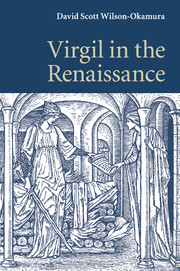Book contents
- Frontmatter
- Dedication
- Contents
- Illustrations
- Acknowledgements
- Texts and abbreviations
- Introduction
- Part I Publication
- Part II Reputation
- Chapter 2 Patronage and the Eclogues
- Chapter 3 Variety and the Georgics
- Chapter 4 Morals and minimalism
- Part III Interpretation
- Appendix A Virgil commentaries in Latin editions, 1469–1599
- Appendix B Virgil commentaries ranked by number of printings
- Index
- References
Chapter 4 - Morals and minimalism
from Part II - Reputation
Published online by Cambridge University Press: 05 March 2014
- Frontmatter
- Dedication
- Contents
- Illustrations
- Acknowledgements
- Texts and abbreviations
- Introduction
- Part I Publication
- Part II Reputation
- Chapter 2 Patronage and the Eclogues
- Chapter 3 Variety and the Georgics
- Chapter 4 Morals and minimalism
- Part III Interpretation
- Appendix A Virgil commentaries in Latin editions, 1469–1599
- Appendix B Virgil commentaries ranked by number of printings
- Index
- References
Summary
Leibniz has a parable about two libraries: one of a hundred different books of different worth, the other of a hundred books that are all equally perfect. It is significant that the latter consists of a hundred Aeneids.
Jorge Luis Borges (trans. Eliot Weinberger)Virgil the reviser
The richest and perhaps most interesting of the clichés about Virgil was his refinement. As we have seen, Virgil’s poetry was revered almost universally for its scope and versatility; its variety resembled Nature in seeming to be endless. But Nature is careless, undependable; it requires supervision, guidance, and cultivation. What it wants is refinement, and refinement was supposed to be Virgil’s specialty.
Again, the tradition begins in antiquity. In Horace, Virgil’s song is described as “smooth and polished” (molle atque facetum). Varius Rufus, who was assigned to edit and publish the Aeneid after Virgil’s death, records that the poet composed slowly, only a few lines a day. According to Aulus Gellius, Virgil boasted of making verses
after the manner and fashion of a bear. For as that beast, he said, brought forth her young formless and misshapen (ineffigiatum informemque), and afterwards by licking the young cub gave it form and shape (conformaret & fingeret), just so the fresh products of his mind were rude in form and imperfect, but afterwards by working them over and polishing them (tractando colendoque) he gave them a definite form and expression.
- Type
- Chapter
- Information
- Virgil in the Renaissance , pp. 101 - 142Publisher: Cambridge University PressPrint publication year: 2010



